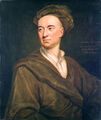Template:On This Day (nonfiction)/February 27: Difference between revisions
(Created page with "<gallery> || *** DONE: Pics *** File:Franciscus_Raphelengius.jpg|link=Franciscus Raphelengius (nonfiction)|1539: Scholar, printer, and bookseller Franciscus Raphelengius (n...") |
No edit summary |
||
| (One intermediate revision by the same user not shown) | |||
| Line 5: | Line 5: | ||
||1630: Roche Braziliano born ... pirate. DOB uncertain? Pic. | ||1630: Roche Braziliano born ... pirate. DOB uncertain? Pic. | ||
File:John Arbuthnot.jpg|link=John Arbuthnot (nonfiction)|1735: Polymath [[John Arbuthnot (nonfiction)|John Arbuthnot]] dies. Arbuthnot invented the figure of John Bull. | File:John Arbuthnot.jpg|link=John Arbuthnot (nonfiction)|1735: Polymath [[John Arbuthnot (nonfiction)|John Arbuthnot]] dies. Arbuthnot invented the figure of John Bull. | ||
| Line 47: | Line 45: | ||
File:Carbon 14 formation and decay.svg|link=Carbon-14 (nonfiction)|1940: Martin Kamen and Sam Ruben discover [[Carbon-14 (nonfiction)|carbon-14]]. Its presence in organic materials is the basis of the radiocarbon dating method pioneered by Willard Libby and colleagues (1949) to date archaeological, geological and hydrogeological samples. | File:Carbon 14 formation and decay.svg|link=Carbon-14 (nonfiction)|1940: Martin Kamen and Sam Ruben discover [[Carbon-14 (nonfiction)|carbon-14]]. Its presence in organic materials is the basis of the radiocarbon dating method pioneered by Willard Libby and colleagues (1949) to date archaeological, geological and hydrogeological samples. | ||
||1942: Operation Biting, also known as the Bruneval Raid, was a British Combined Operations raid on a German coastal radar installation at Bruneval in northern France during the Second World War, on the night of 27–28 February 1942. Pic. | |||
||1943: "Dilly" Knox dies ... classics scholar and papyrologist at King's College, Cambridge and a codebreaker. As a member of the Room 40 codebreaking unit he helped decrypt the Zimmermann Telegram which brought the USA into the First World War. He joined the Government Code and Cypher School (GC&CS) at the war's end. Pic search. | ||1943: "Dilly" Knox dies ... classics scholar and papyrologist at King's College, Cambridge and a codebreaker. As a member of the Room 40 codebreaking unit he helped decrypt the Zimmermann Telegram which brought the USA into the First World War. He joined the Government Code and Cypher School (GC&CS) at the war's end. Pic search. | ||
| Line 53: | Line 53: | ||
||1955: Erich Regener dies ... physicist known primarily for the design and construction of instruments to measure cosmic ray intensity at various altitudes. He is also known for predicting a 2.8 K cosmic background radiation, for the invention of the scintillation counter which contributed to the discovery of the structure of the atom, for his calculation of the charge of an electron and for his early work on atmospheric ozone. He is also credited with the first use of rockets for scientific research. Pic. | ||1955: Erich Regener dies ... physicist known primarily for the design and construction of instruments to measure cosmic ray intensity at various altitudes. He is also known for predicting a 2.8 K cosmic background radiation, for the invention of the scintillation counter which contributed to the discovery of the structure of the atom, for his calculation of the charge of an electron and for his early work on atmospheric ozone. He is also credited with the first use of rockets for scientific research. Pic. | ||
||1987: Bill Holman dies ... cartoonist. Pic. | ||1987: Bill Holman dies ... cartoonist. Pic. | ||
Latest revision as of 09:25, 16 June 2022
1539: Scholar, printer, and bookseller Franciscus Raphelengius born. Raphelengius will produce an Arabic-Latin dictionary, about 550 pages, which will be published posthumously in 1613 at Leiden — the first publication by printing press of a book-length dictionary for the Arabic language in Latin.
1735: Polymath John Arbuthnot dies. Arbuthnot invented the figure of John Bull.
1869: Physician, research scientist, and author Alice Hamilton born. Hamilton will be a leading expert in the field of occupational health and a pioneer in the field of industrial toxicology.
1881: Mathematician and philosopher L. E. J. Brouwer born. Brouwer will make contributions to topology, set theory, measure theory and complex analysis; and he will found the mathematical philosophy of intuitionism.
1940: Martin Kamen and Sam Ruben discover carbon-14. Its presence in organic materials is the basis of the radiocarbon dating method pioneered by Willard Libby and colleagues (1949) to date archaeological, geological and hydrogeological samples.




